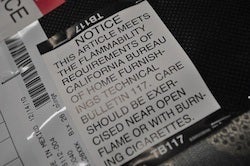March 23, 2012
Did you know that your couch most likely contains up to a pound of flame retardants? And that these are toxic chemicals that may cause cancer, harm reproduction, or adversely impact brain development?
In a March 6, 2012 talk at Harvard School of Public Health (HSPH), Arlene Blum—a biophysical chemist, visiting scholar in chemistry at the University of California, Berkeley, and founder and executive director of the Green Science Policy Institute—described the potential public health dangers of flame retardants and her efforts to keep these substances out of everything from sofas to nursing pillows.
The talk was sponsored by HSPH’s National Institute of Environmental Health Sciences Center.
Adverse Health Effects
Blum has been researching flame retardants since the 1970s. She has studied couches, computers, baby products, and more to discover the chemicals they contain; found that these substances actually provide little or no benefit; and worked to convince politicians and government agencies that laws requiring flame retardants in products may do much more harm than good.
While the FDA regulates chemicals in food and drugs, and the EPA does so for pesticides, a whole range of other consumer goods—personal care items, cleaning products, home and office furniture, household electronics—are not regulated by the federal government. As a result, Blum contends, most of us use these products without realizing they may include harmful chemicals.
The chemicals in flame retardants, which are similar to the banned pesticides DDT and Mirex, have been associated in numerous animal studies with adverse effects on reproduction, brain development, the endocrine system, immunity, and the nervous system. These chemicals persist in the body for many years. Babies are particularly vulnerable, accumulating the substances through the placenta, breastfeeding, and through foam in products such as stroller cushions or baby carriers. In recent years, increasing levels of these chemicals have been found in coastal waters, in large marine mammals, at the North and South poles, and in the atmosphere, Blum noted.
Exposure in the Home
Flame retardants in children’s pajamas were banned in the late 1970s after Blum and others authored academic papers detailing their dangers. But most furniture made in the United States contains similarly toxic flame retardants because of a California flammability standard known as Technical Bulletin 117, enacted in 2000, that requires polyurethane foam to be able to withstand a small open flame for 12 seconds.
The flame retardant, called chlorinated TRIS, leaches out of products and accumulates as dust inside homes. Ironically, said Blum, studies have found no significant difference in the burn rate between flame-retardant couches and those without flame retardants. And when treated couches do burn, they release large amounts of toxic gases.
“So by filling your couch with Tris, you get 12 seconds delay in ignition, but way more toxic gases,” Blum said. “And what do you think kills people in fires? Toxic gases.”
Despite the evidence suggesting flame retardants’ negative health impact—and despite the fact that there are other ways to reduce flammability, such as by using naturally fire-resistant fabrics—chemical companies have spent millions lobbying for their continued use, Blum said.
Still, she has succeeded a dozen times in convincing policymakers to vote against proposed new uses of flame retardants, by sharing peer-reviewed science with them about the substances’ dangers.
“There are a small number of really problematic chemicals, and in many cases they have no purpose,” she said. “I think our good science can help change policy and prevent a lot of illnesses.”
–Karen Feldscher
photo: Aubrey LaMedica
